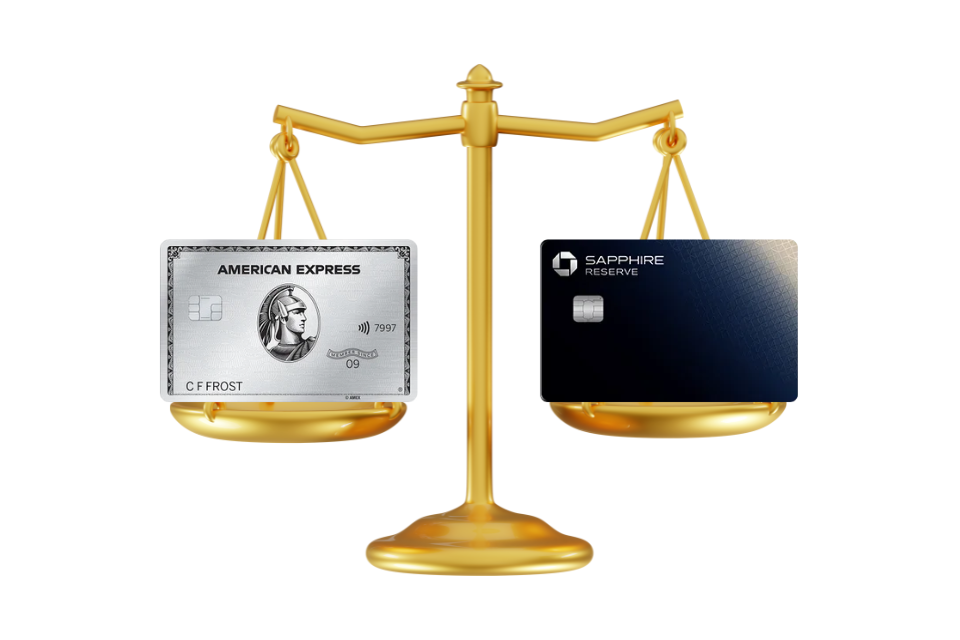The Platinum Card® from American Express and the Chase Sapphire Reserve® are among the most expensive credit cards on the market. However, if you’re a travel enthusiast, the benefits these premium credit cards offer can easily outweigh their costs.
But with many overlapping perks, it doesn’t make sense for most people to have both, so it’s important to carefully compare the two options to determine which is better for you.
Note that both cards have had changes or will soon experience changes. The , and there’s an upcoming in the second half of 2025.
The Amex Platinum has a $695 annual fee, while the Chase Sapphire Reserve has a $795 annual fee. Both fees are high, but the Amex Platinum has the lower yearly cost.
Here’s how the Amex Platinum and Chase Sapphire Reserve welcome offers compare:
-
Amex Platinum: You may be eligible for as high as 175,000 Membership Rewards® Points after spending $8,000 within the first six months (welcome offers vary and you may not be eligible for an offer). Apply to know if you’re approved and find out your exact welcome offer amount, all with no credit score impact (if you’re approved and choose to accept the Card, your score may be impacted).
-
Chase Sapphire Reserve: Earn 100,000 bonus points plus a $500 Chase Travel promo credit after spending $5,000 in the first 3 months.
The Amex Platinum may have the more generous welcome offer in terms of points earning potential, but not everyone will be eligible for the full amount. You also have to spend more to receive it. In general, the Sapphire Reserve bonus is a more straightforward option.
Here’s how the Amex Platinum and Chase Sapphire Reserve earning rates stack up against each other:
The Chase Sapphire Reserve has the better overall rewards rate because it provides multiple useful bonus categories for frequent travelers. The Amex Platinum has 5x on airfare booked directly with airlines, but it doesn’t have the additional categories of hotels booked directly and worldwide dining purchases.
At a glance, the Amex Platinum offers over $1,500 in potential value, while the Chase Sapphire Reserve offers over $2,700 in potential value. You might automatically assume that makes the Sapphire Reserve better, but it depends on your travel preferences. Meaning, there’s no clear winner here because the better card for you depends on which benefits you would use.
Transfer partners provide increased flexibility with reward redemptions, sometimes offering much more value compared to traditional redemptions, such as cash back or gift cards.
American Express has more transfer partners than Chase, but that doesn’t immediately make the Amex Platinum better, as it depends on which transfer partners you might actually use. Both cards provide access to useful partners, so it comes down to your travel preferences.
You may consider the Platinum Card if you’re a frequent traveler and value premium benefits on every trip you take.
However, the card’s steep annual fee and complicated perks are best suited for people who are willing to do a little extra work to get the most value out of it.
-
Annual fee
$695
-
Welcome offer
You may be eligible for as high as 175,000 Membership Rewards® Points after spending $8,000 within the first 6 months (welcome offers vary and you may not be eligible for an offer); apply to know if you’re approved and find out your exact welcome offer amount – all with no credit score impact (if you’re approved and choose to accept the Card, your score may be impacted)
-
Rewards rate
- 5x points for flights booked directly with airlines or with American Express Travel® (up to $500,000 per calendar year)
- 5x points on prepaid hotels booked with American Express Travel
- 1x points on all other purchases
-
Benefits
- Get up to $200 back in statement credits each year on prepaid Fine Hotels + Resorts or The Hotel Collection bookings with American Express Travel (requires a minimum two-night stay)
- Get up to $199 in statement credits per calendar year after you pay for your CLEAR Plus Membership (subject to auto-renewal) with the Platinum Card
- Enjoy up to $200 in Uber savings annually on rides in the U.S. — that’s $15 in Uber Cash for rides each month, plus a bonus $20 in December (you must have the latest version of the Uber App downloaded and your eligible American Express Platinum Card must be a method of payment in your Uber account; Amex benefit may only be used in United States)
The Sapphire Reserve also has a very high annual fee, but plenty of opportunities to recoup the cost. With a broader range of rewards categories, you may prefer this option if you want to focus on earning rewards.
The Sapphire Reserve also offers a unique and flexible annual travel credit, which applies to the first $300 you spend on travel each account anniversary year. That said, you should compare each of the Sapphire Reserve’s annual credits and benefits to your own travel preferences to decide whether it makes sense for your spending.
-
Annual fee
$795
-
Welcome offer
Earn 100,000 bonus points plus a $500 Chase Travel℠ promo credit after spending $5,000 in the first 3 months
-
Rewards rate
- 8x points on all purchases through Chase Travel℠
- 4x points on flights and hotels booked direct
- 3x points on dining worldwide
- 1x points on all other purchases
-
Benefits
- Get up to $150 in statement credits every six months for a maximum of $300 annually for dining at restaurants that are part of Sapphire Reserve Exclusive Tables
- Trip Cancellation/Interruption Insurance, Auto Rental Coverage, Lost Luggage Insurance, no foreign transaction fees, and more
- Receive up to a $120 statement credit every four years to cover the application fee for Global Entry, TSA PreCheck, or NEXUS
For the most enthusiastic travel rewards hobbyists, there are enough differences between the two cards to justify getting the best of both worlds. True jet-setters may want to maximize the spending rewards of the Sapphire Reserve and the luxury perks of the Amex Platinum.
However, the majority of people might not be willing to pay such a large amount in annual fees to carry both cards. And unless you’re traveling constantly, the perks overlap enough that you’ll have a hard time maximizing either card.
While the Amex Platinum and Sapphire Reserve are two of the top premium cards on the market, there are plenty of other that offer ample rewards and benefits.
-
Rewards rate
- 10x miles on hotels and rental cars booked through Capital One Travel
- 5x miles on flights and vacation rentals booked through Capital One Travel
- 2x miles on all other purchases
-
Benefits
- $300 annual credit for travel bookings through Capital One Travel
- 10,000 annual bonus miles (worth $100 in travel spending; starts on your first account anniversary)
- Unlimited access for you and two guests to Capital One Lounges and 1,300+ more lounges through partner networks after enrollment
Why we like it: The Capital One Venture X Rewards Credit Card is a premium travel credit card that can work for both frequent and casual travelers.
The card charges a hefty annual fee, but you can easily offset that with its annual credit toward Capital One Travel bookings and a 10,000-mile anniversary bonus each year. You can use miles to book travel through Capital One, book on your own and request a statement credit, or transfer your rewards to several airline and hotel loyalty program partners.
-
Rewards rate
- 5x points on travel purchased through Chase Travel℠
- 3x points on dining, select streaming services, and online groceries
- 2x points on all other travel purchases
- 1x points on all other purchases
- $50 Annual Chase Travel Hotel Credit
-
Benefits
- Complimentary DashPass with $0 delivery fees & lower service fees for a min. of one year when you activate by 12/31/27, plus a $10 promo each month on non-restaurant orders
- Earn up to $50 in annual statement credits for hotel stays purchased through Chase Travel
- On every account anniversary, earn bonus points equal to 10% of your total purchases made the previous year
Why we like it: The Chase Sapphire Preferred Card has an affordable annual fee that’s easier to stomach compared to premium cards. That said, the card still offers impressive value. It has a valuable welcome bonus and solid rewards on travel, dining, select online grocery purchases, and streaming services.
Redeeming points for travel bookings through Chase can also boost your rewards value.
-
Annual fee
$95
-
Welcome offer
Earn 75,000 miles after spending $4,000 on purchases in the first 3 months – that’s equal to $750 in travel
-
Rewards rate
- 5x miles on hotels, vacation rentals, and rental cars booked through Capital One Travel
- 2x miles on all other purchases
-
Benefits
- Receive up to a $120 statement credit for Global Entry or TSA Precheck application fees
- Receive a $50 experience credit, room upgrades, and early check-in at eligible hotels
- Access Hertz’s Five Star membership tier, offering free upgrades, a wider selection of vehicles, and more
Why we like it: As with the Sapphire Preferred, the Capital One Venture Rewards Credit Card charges a modest annual fee.
The Venture Rewards Card offers the same flexible travel redemption options as the Venture X, making it easy to use your rewards for any kind of travel. In addition, you’ll get an application fee credit toward Global Entry or TSA PreCheck and elite status with Hertz.
It depends on which benefits between the Amex Platinum and Sapphire Reserve you would use more. Both cards have loads of perks and credits, but not everyone can use them in their everyday lives. Compare both cards to see which benefits align with your lifestyle and travel preferences, and you’ll see which is the better option.
The Chase Sapphire Reserve and Chase Sapphire Preferred used to have a rule where you could only receive one Chase Sapphire bonus every 48 months. The current rule is that you’re not eligible for a sign-up bonus on any Sapphire product on which you’ve earned a bonus before. You’re also not eligible for a bonus on a Sapphire product if you’re a current Sapphire cardholder.
Amex Platinum cardholders can access the Chase Sapphire by The Club lounge network, excluding the Hong Kong International Airport (HKG) location, once per calendar year. Each visit after the first will cost $75 per person per visit.
The if you’re able to use its many perks and credits. Notably, you can receive over $2,700 in annual value from its travel and lifestyle benefits, which far outweigh its $795 annual fee. However, you might not find every benefit useful or easy to use unless you travel a lot.
How do the annual fees for the Amex Platinum and Sapphire Reserve compare?
The Amex Platinum has a $695 annual fee, while the Sapphire Reserve has a $795 annual fee.
Editorial Disclosure: The information in this article has not been reviewed or approved by any advertiser. All opinions belong solely to the author(s) and are not those of any other entity. The details on financial products, including card rates and fees, are accurate as of the publish date. All products or services are presented without warranty. Check the bank’s website for the most current information. This site doesn’t include all currently available offers. Credit score alone does not guarantee or imply approval for any financial product.






